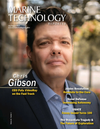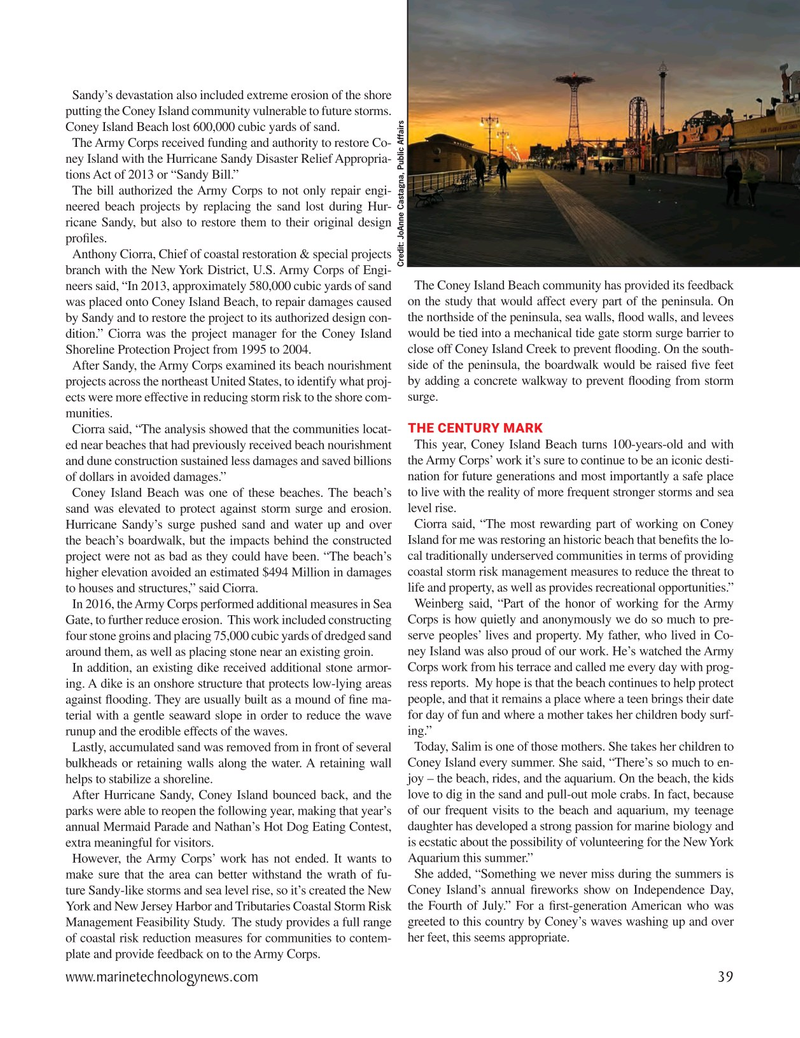
Page 39: of Marine Technology Magazine (July 2023)
Read this page in Pdf, Flash or Html5 edition of July 2023 Marine Technology Magazine
Sandy’s devastation also included extreme erosion of the shore putting the Coney Island community vulnerable to future storms.
Coney Island Beach lost 600,000 cubic yards of sand.
The Army Corps received funding and authority to restore Co- ney Island with the Hurricane Sandy Disaster Relief Appropria- tions Act of 2013 or “Sandy Bill.”
The bill authorized the Army Corps to not only repair engi- neered beach projects by replacing the sand lost during Hur- ricane Sandy, but also to restore them to their original design pro? les.
Anthony Ciorra, Chief of coastal restoration & special projects
Credit: JoAnne Castagna, Public Affairs branch with the New York District, U.S. Army Corps of Engi- neers said, “In 2013, approximately 580,000 cubic yards of sand The Coney Island Beach community has provided its feedback was placed onto Coney Island Beach, to repair damages caused on the study that would affect every part of the peninsula. On by Sandy and to restore the project to its authorized design con- the northside of the peninsula, sea walls, ? ood walls, and levees dition.” Ciorra was the project manager for the Coney Island would be tied into a mechanical tide gate storm surge barrier to
Shoreline Protection Project from 1995 to 2004. close off Coney Island Creek to prevent ? ooding. On the south-
After Sandy, the Army Corps examined its beach nourishment side of the peninsula, the boardwalk would be raised ? ve feet projects across the northeast United States, to identify what proj- by adding a concrete walkway to prevent ? ooding from storm ects were more effective in reducing storm risk to the shore com- surge.
munities.
Ciorra said, “The analysis showed that the communities locat- THE CENTURY MARK ed near beaches that had previously received beach nourishment This year, Coney Island Beach turns 100-years-old and with and dune construction sustained less damages and saved billions the Army Corps’ work it’s sure to continue to be an iconic desti- of dollars in avoided damages.” nation for future generations and most importantly a safe place
Coney Island Beach was one of these beaches. The beach’s to live with the reality of more frequent stronger storms and sea sand was elevated to protect against storm surge and erosion. level rise.
Hurricane Sandy’s surge pushed sand and water up and over Ciorra said, “The most rewarding part of working on Coney the beach’s boardwalk, but the impacts behind the constructed Island for me was restoring an historic beach that bene? ts the lo- project were not as bad as they could have been. “The beach’s cal traditionally underserved communities in terms of providing higher elevation avoided an estimated $494 Million in damages coastal storm risk management measures to reduce the threat to to houses and structures,” said Ciorra. life and property, as well as provides recreational opportunities.”
In 2016, the Army Corps performed additional measures in Sea Weinberg said, “Part of the honor of working for the Army
Gate, to further reduce erosion. This work included constructing Corps is how quietly and anonymously we do so much to pre- four stone groins and placing 75,000 cubic yards of dredged sand serve peoples’ lives and property. My father, who lived in Co- around them, as well as placing stone near an existing groin. ney Island was also proud of our work. He’s watched the Army
In addition, an existing dike received additional stone armor- Corps work from his terrace and called me every day with prog- ing. A dike is an onshore structure that protects low-lying areas ress reports. My hope is that the beach continues to help protect against ? ooding. They are usually built as a mound of ? ne ma- people, and that it remains a place where a teen brings their date terial with a gentle seaward slope in order to reduce the wave for day of fun and where a mother takes her children body surf- runup and the erodible effects of the waves. ing.”
Lastly, accumulated sand was removed from in front of several Today, Salim is one of those mothers. She takes her children to bulkheads or retaining walls along the water. A retaining wall Coney Island every summer. She said, “There’s so much to en- helps to stabilize a shoreline. joy – the beach, rides, and the aquarium. On the beach, the kids
After Hurricane Sandy, Coney Island bounced back, and the love to dig in the sand and pull-out mole crabs. In fact, because parks were able to reopen the following year, making that year’s of our frequent visits to the beach and aquarium, my teenage annual Mermaid Parade and Nathan’s Hot Dog Eating Contest, daughter has developed a strong passion for marine biology and extra meaningful for visitors. is ecstatic about the possibility of volunteering for the New York
However, the Army Corps’ work has not ended. It wants to Aquarium this summer.” make sure that the area can better withstand the wrath of fu- She added, “Something we never miss during the summers is ture Sandy-like storms and sea level rise, so it’s created the New Coney Island’s annual ? reworks show on Independence Day,
York and New Jersey Harbor and Tributaries Coastal Storm Risk the Fourth of July.” For a ? rst-generation American who was
Management Feasibility Study. The study provides a full range greeted to this country by Coney’s waves washing up and over of coastal risk reduction measures for communities to contem- her feet, this seems appropriate.
plate and provide feedback on to the Army Corps. www.marinetechnologynews.com 39
MTR #5 (34-48).indd 39 7/27/2023 8:23:21 AM

 38
38

 40
40
